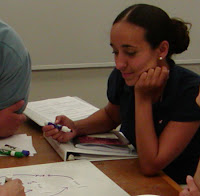What does a diet of
tapeworms or designing your own roller coaster have to do with engaging
students in successful science? Actually, these may have a whole lot to do
with keeping their interest, as researcher, educator and author Arthur
Beauchamp has found. Using what he learned from his preliminary research in
classroom science curriculum, Beauchamp has developed a science literacy
framework to help teachers engage the previously unengaged student, as well
as those who already love science – by challenging their critical thinking
skills to develop an ability to analyze data like a real scientist.
“When students get to
talk about their own understanding, the nature of the classroom changes. It
becomes a far more engaged setting for students.” – Arthur Beauchamp
Photos provided by Arthur Beauchamp |
SHAN: Why is a book like
yours needed?
ARTHUR: A book like this is
needed because as we looked around at secondary science classrooms there was
something lacking in the learning and understanding of science. It seemed
there were some good tools in the English Language Arts that could be used to
help students understand science better.
This book addresses two
challenges science teachers face. The first challenge is how to use a
framework to put Language Arts tools into use with science instruction.
Second, is how teachers can select the most appropriate techniques for their
particular science instruction.
So the book provides a framework and provides tools within that framework. Also, when we took a look at who was doing the talking in science classrooms, a great deal of teacher talk was occurring and not nearly as much enough student dialogue or student thinking was taking place. |
This book also helps
teachers with techniques to manage student talk. For example, when we look at
student writing in science, we find very few instances where student thinking
is prevalent in the writing. And this book gives techniques in the context of
science to help teachers design writing tasks for students. So overall it
fills the need of helping science teachers to use English Language Arts
techniques to teach their subject.
|
SHAN: How would you suggest
teachers use your book?
ARTHUR: I’d suggest teachers use it as a lens
to look at lessons and a design framework as they construct those lessons. It
gives teachers two things. First it gives them a road map they can keep in
mind in the design of different aspects of the lesson – and then it gives
tools to use within that framework.
|
For example, by using this
book a teacher would be assisted in how they could move through a lesson –
drawing on dialogue, reading, and writing as very robust ways of helping
students understand science.
There are other payoffs –
in addition to greater science understanding – student reading improves and
student writing improves.
|
For more information about Success
in Science through Dialogue, Reading and Writing, and associated
professional development please visit: http://sasp.ucdavis.edu
Shän Boggs is a writer and editor living in California.
Her interests include science, technology, the environment, health, education,
multimedia, art, and gourmet cooking.
October 8, 2013
The National Science Teachers Association recommends "Success in Science through Dialogue, Reading and Writing."


